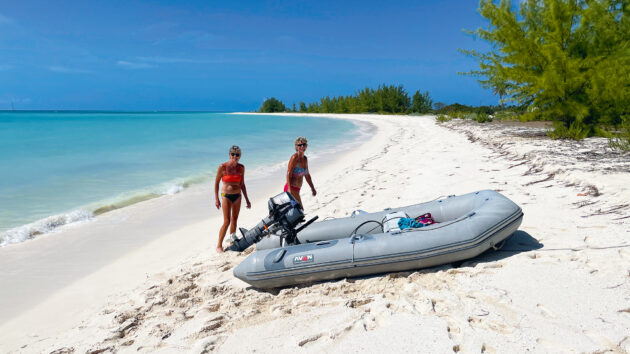When a change in the weather leads to serious damage to Simon Hardaker’s outboard and no spares available anywhere, he resorts to ingenuity and improvisation to keep the show on the road
Our dinghy is the equivalent of everyone’s car at home; it’s how we get from our boat at anchor, to anywhere in the harbour. Used most days, it has to accommodate one or all of us – there’s often four aboard – together with bags of laundry and shopping, or just going for drinks, food or to explore ashore.
When the dinghy or its engine gives any trouble at all, it quickly becomes a problem. Unless you have an alternative means of getting to and from the boat, you may need a more expensive marina berth, assuming one is available, until the issue is resolved.
Two incidents in the Caribbean recently serve to illustrate that even in somewhere with so little rise and fall of tide, where you leave your dinghy needs more than a cursory consideration. And small changes in wind direction in under an hour can change the swell conditions in an anchorage and make what looks like a benign dinghy dock into a really dangerous spot.
If you do have a problem, spares to make repairs may not be as readily available as in the UK or US. So, what alternatives have you got, and what tools do you have on board to help?
The first incident happened at Falmouth Harbour, Antigua. It’s quite a common occurrence in the Caribbean and elsewhere in the world, even around the equator with low rise and fall of tide.

The bridge where Simon should have moored the dinghy in Bouillante, Guadeloupe
Caribbean weather
The dinghy dock in Falmouth Harbour is large enough to accommodate dozens of dinghies from around the great natural harbour there and it’s busy all of the time.
Dinghies of all shapes, sizes (and budgets) are variously secured on short and long tethers. Inevitably, sometimes a boat ends up where it shouldn’t be.
Over any period of time, dinghies come and go and what looked secure 30 minutes ago could become a liability as people circulate. In this particular case, a dinghy had become trapped underneath the dock on a long tether beneath the planks of the dock’s side as the tide rose.
It was simple enough to release it by bleeding air from the inflatable tubes in order to ‘sink’ it a little, and pump them right up again with our pump once on the right side of the dock. But without their own pump, their dinghy was stuck fast with the engine under the pontoon.

Simon Hardaker has been sailing for decades, enjoying everything from the spills and thrills of racing catamarans around the cans to offshore racing in Fastnets
The second incident was at Bouillante in Guadeloupe and had rather more drastic-looking consequences. Safely at anchor, we’d spotted the dinghy dock connected by a bridge to the shore. Several boats had secured their dinghies to the bridge rather than to the dock. We thought it was a bit odd when there was a perfectly good dock to tie to. We really should have followed their example. Instead, we ignored the bridge, tied up to the dock, and left to do our shopping.
We returned to the dock some hours later, laden with shopping. There was by now quite a swell running in the bay. As each wave rolled in, our dinghy rose and fell beneath the dock under which it had floated, and the engine was being pounded from above by the concrete pier. The engine cover and gearshift lever were taking a beating.
Article continues below…
‘I spent hours in the water in hurricane conditions’
When we saw the race briefing it was a little bit fuzzy,’ John Quinn told me, recalling events that had…
‘The salty water was dangerously reaching the cockpit edge and we had to prevent the boat from taking too much water’
I first saw the boat after reading a small advertisement in a local newspaper. It was lying under a red…
A grim diagnosis
Once the dinghy and engine were freed from the immediate danger under the dock, we tried to shift the gear lever back to neutral to start the engine. No luck.
A closer inspection revealed part of the mechanism to prevent the engine starting in gear was in several pieces.
It was impossible to start the engine. Although we had oars on board, the row back would have been long and very hard work. Luckily for us, one of our friends in the bay was able to come and tow us back to our boat.
With the outboard laid out on the cockpit table, I could see several broken and twisted bits of plastic, disconnected control rods and a displaced and seized gearshift shaft.

The trapped dinghy in Falmouth Harbour, with the engine stuck under the dock
My usual mindset is that I’m able to make or at least attempt most repairs on board when things go wrong. This broken mess looked like it would need some particular spares and maybe some professional help though.
The following day, we sailed around to the main port on the island at Pointe-à-Pitre, expecting to be able to find the support and spares that we needed. On asking around locally, there were none of the spares I needed and no one that could help with the repair. We explored the worst-case scenario and started looking for a new outboard. The price of a replacement was eye-watering and clearly going to make a serious dent in the boat finances.

The broken part of the gear shift cam prior to its repair
A lucky break
I had a piece of fortune though, as I was returning to the dock where we were now berthed after my fruitless search for spares. Passing a workshop that was having a major facelift with bits and pieces everywhere, I noticed part of the shop that had a solid looking bench and space to work.
More in hope than expectation, I explained to the manager about my dinghy engine problem and asked if, as there appeared to be a temporary usable space, could I use it to attempt repairs? Thankfully, he was happy to let me have the space for a few hours.
When you know you have no choice but to make a repair yourself with whatever you have to hand, some creative thinking and confidence with your tools are needed. Anyone that’s worked on compact two-stroke dinghy outboards will know that, while not overly complicated, if something is broken, it inevitably requires quite a lot of disassembly to get to the heart of the problem. In our case, the carburettor and several links to it had to come off.

Simon in the workshop at Pointe-à-Pitre
Once I could get at the mechanism, I collected the bits of broken plastic and, with a mix of mole grips and judicious use of a lead-weighted mallet that I have, managed to free and remove the metal gearshift shaft from the other plastic gearshift clamps and mouldings.
I managed to dry-fit all the pieces of plastic together, firstly to make sure I’d got all the bits, and secondly to see that I could glue it all back together. With fast-setting two-part epoxy, and some seizing wire to hold it all in place, I repaired the plastic clamp connecting the gearshift lever to the rod mechanism that prevents the engine being started in-gear. Putting the whole lot back together was straightforward enough and cost me only a couple of cold beers for the workshop manager.
Despite the fact that I’ve since received the right spares, the glued together and wired components are still working. They will only be replaced in the winter engine service.

Simon with his outboard in the British Virgin Islands
Lessons learned
Moor with care – If you rely on the dinghy as your only way to get ashore, wherever you secure it, consider the rise and fall of tide and, if packed in with other craft, with the length of strop that you leave, what could happen if other dinghies left, the tide came in, or swell increased?
Onboard essentials – Keep the pump in the dinghy if you can, and oars, just in case you’re immobilised.
Online resources – If you enter an anchorage and see where everyone else has left their dinghies, don’t assume that you know better. Apps like Navily, www.navily.com, or the Cruising Association’s CAptainsMate, available to members of the Cruising Association, have lots of useful information like where to anchor and the conditions that you might encounter.
Our after-event report on Navily makes it very clear how to tie up to the bridge in the particular bay where we came to grief.
Carry some spares – Spares, even for a common dinghy engine, are not available everywhere and especially far from major supply lines. Even if they’re available, it could be weeks before they arrive, and expensive. Before we left the UK, I had bought a lot of spares, but they were almost all for the yacht.
Basic repair kit – You won’t be able to carry the spares to fix everything, you’d need another boat. Carry things like two-part epoxy; we use Araldite Ultra Strong and underwater epoxy. We also use a thing called PC-11. Both are better than just ‘standard’ superglue for heavy-duty repairs, and the latter even works well underwater.
You’ve probably got seizing wire to secure shackles, I used it around the plastic after gluing it to give it extra security. So, it could be using something you have, but not for its actual purpose, which solves your problem. Only experience will tell you what tools to carry, but heavy hammers and solid grips are helpful in a lot of applications.
Enjoyed reading this?
A subscription to Yachting Monthly magazine costs around 40% less than the cover price, so you can save money compared to buying single issues.
Print and digital editions are available through Magazines Direct – where you can also find the latest deals.
YM is packed with information to help you get the most from your time on the water.
-
-
- Take your seamanship to the next level with tips, advice and skills from our experts
- Impartial in-depth reviews of the latest yachts and equipment
- Cruising guides to help you reach those dream destinations
-
Follow us on Facebook, Twitter and Instagram.






